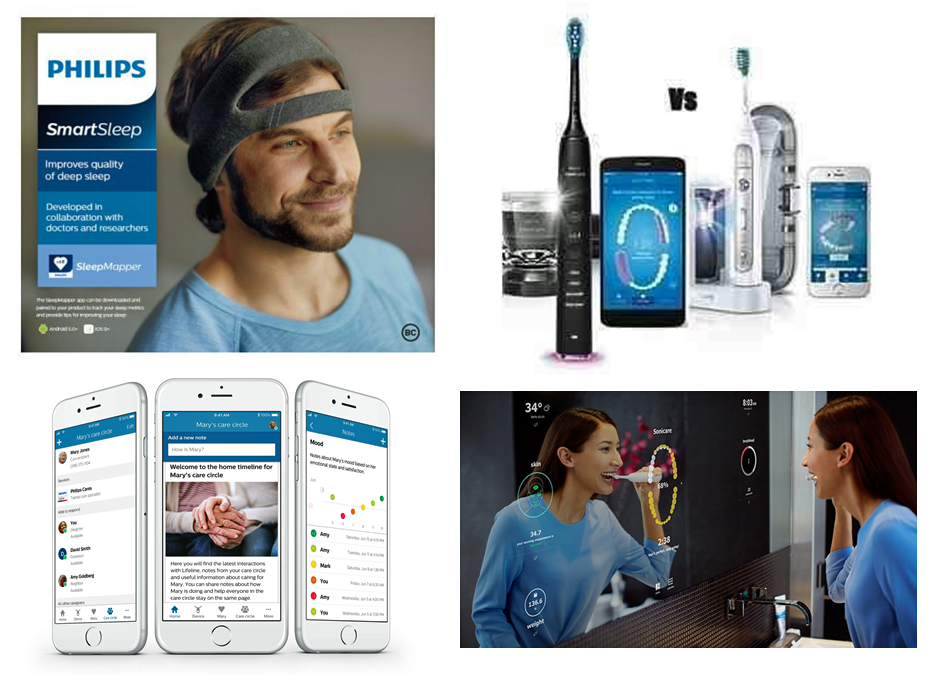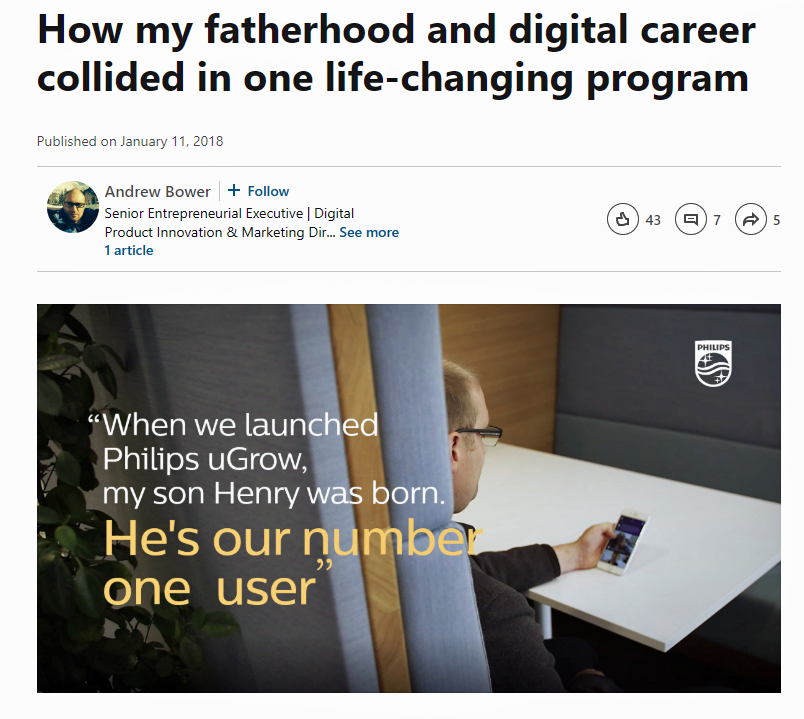Our homes should nurture our health. In addition to nutrition and good food, positive relationships, clean air and water, and the basic needs that bolster whole health, technology is playing a growing role to help us manage health at home.
 At CES 2019, I spent time with Roy Jakobs, Chief Business Leader of Personal Health with Philips, to discuss the company’s evolving portfolio of products that help fulfill the mission to support people across their own continuum of health. Following CES, I wanted to further dive into one part of the portfolio very important to family health at home: the mother-and-child segment. Last week, I had a phone call with Andrew Bower, Head of Digital Solutions & Services for Mother & Child Care who’s been deeply involved in the company’s mother-and-childcare business.
At CES 2019, I spent time with Roy Jakobs, Chief Business Leader of Personal Health with Philips, to discuss the company’s evolving portfolio of products that help fulfill the mission to support people across their own continuum of health. Following CES, I wanted to further dive into one part of the portfolio very important to family health at home: the mother-and-child segment. Last week, I had a phone call with Andrew Bower, Head of Digital Solutions & Services for Mother & Child Care who’s been deeply involved in the company’s mother-and-childcare business.
Exploring Philips’ CES 2019 updates, Roy told me the group has the bold, overarching mission to improve peoples’ lives. As the management lead on personal health solutions, Roy explained that the company recognizes consumers are getting increasingly engaged in health: for themselves and their loved ones (whether aging parent or newborn child). Philips looks for health engagement across the care continuum, as the first graphic illustrates, with solutions that are deployed on the clinical/medical side of health in diagnosis and treatment in hospitals, as well as for at-home care. As more clinical care is shifted to the home (the right side of the continuum in the chart), Philips believes that our homes can be “natural habitats for recovery,” Roy said. For health systems, this shift is becoming an attractive way to deal with triaging care to the most cost-effective site that can ensure optimal health outcomes and address consumers’ personal goals and expectations for health engagement.
 Personal care at Philips covers a wide range of self-care including sleep, nutrition, grooming, oral care, respiratory care, emergency support, aging and caregiving, and mother and baby. At CES 2019, Philips announced expanding partnerships in these areas: for sleep, Fitbit is a partner leveraging their API ecosystem, and Sleeprate is a sleep improvement system underpinned by cognitive behavioral therapy (CBT). In nutrition, Philips is working with Noom and Hello Fresh. In the Sonicare oral care category, Philips launched a teledentistry service working with Toothpic, a network of virtual dentists.
Personal care at Philips covers a wide range of self-care including sleep, nutrition, grooming, oral care, respiratory care, emergency support, aging and caregiving, and mother and baby. At CES 2019, Philips announced expanding partnerships in these areas: for sleep, Fitbit is a partner leveraging their API ecosystem, and Sleeprate is a sleep improvement system underpinned by cognitive behavioral therapy (CBT). In nutrition, Philips is working with Noom and Hello Fresh. In the Sonicare oral care category, Philips launched a teledentistry service working with Toothpic, a network of virtual dentists.
When it comes to partnering, Roy recognizes that, “We need each other to be effective for the whole sum of the parts” that connect the dots for consumers’ self-care at home and in peoples’ hands.
There’s no more personal care than the journey of a woman in pregnancy and childbirth. Philips’ Pregnancy+ app is indeed very personal to over 3 million people every day who use the app.
With 21 million downloads so far, Pregnancy+ is a platform that supports parents in the baby’s first 1,000 days. These first 1,000 days from conception through baby’s second year are the most important, formative period in a human’s life. A grown-up’s social and medical issues are largely shaped in early childhood, a realization that’s getting greater attention from the health care system with renewed interest in the power of investing in social determinants of health.
The Pregnancy+ app has global reach: 50% of pregnant women in Germany and the UK are using the app, Philips’ market research has found. In the UK, the app is informed by information in collaboration with the National Health Service (NHS). The app is #1 in the pregnancy area of the Apple app store. The apps have seen fast growth, going from 1.3 million to 3.6 million active users on a daily basis. That’s major retention in any app developer’s playbook.
Perhaps that’s because the app provides, “a big hug around the mom,” Andrew believes.

He should know. He used Philips UGrow app as a new Dad. Here’s a snippet from a post he wrote as a new father of son Henry in January 2018.
At CES 2019, Philips launched new features in the Pregnancy+ app. Most impressive in Pregnancy+ is visualization of the pregnancy journey through 3-D images of fetal development. App users can access these images throughout the pregnancy timeline. In addition to these images, the app pushes advice that is relevant to the point-in-time for each user over the nine months. The fetal images can be personalized by ethnicity of the baby, a lovely feature and attention to detail given its global reach.
Philips engaged software engineers from the gaming industry to develop a user experience that’s very engaging and visually enchanting. The team is working on making the Baby+ experience with a similar feel to Pregnancy+.
Parents can query the app, asking all sorts of questions, such as “what’s best to eat for my baby’s wellness and growth?” and, “Can I get tattoo while I’m pregnant?”
Philips continues to grow the pregnancy ecosystem for support through partnerships, recently announcing a strategic investment into Babyscripts. I’ve known this company for a couple of years, meeting them when they were but a young start-up. When I first spoke with Anish Sebastian and Juan Pablo Segura in 2017, I knew they were onto something really important, impactful, and absolutely delightful for the woman at low-risk during pregnancy. Babyscripts identified the subscription box trend before it went mainstream, bundling together a “box” containing a WiFi connected scale, blood pressure monitor, and helpful information to arm a pregnant women with digital tech to self-monitor her health at home. Obstetricians “prescribe” the kit to low-risk maternity patients to use at home, with metrics wirelessly communicated to physicians’ offices. Women self-track and the obstetrician’s staff can observe how mother is doing in terms of her weight gain and blood pressure. If all is well, Mom doesn’t need to go to the doctor’s office as frequently as she would if she wasn’t self-tracking. This alliance reinforces Philips’ approach to the continuum of care for new parents, from lower-risk pregnancies to high-risk ones that may require the need for neonatal intensive care in hospital.
 Further along the mother-and-childcare continuum, Philips supports nutrition and healthy eating for baby, advocating breast feeding and supporting this through an alliance with American Well, the telehealth provider. If Moms have questions about any issues, they can access AmWell’s network of obstetricians, lactation consultants and pediatricians at any time of night or day to relieve anxiety and get professional support when they need it, via the app.
Further along the mother-and-childcare continuum, Philips supports nutrition and healthy eating for baby, advocating breast feeding and supporting this through an alliance with American Well, the telehealth provider. If Moms have questions about any issues, they can access AmWell’s network of obstetricians, lactation consultants and pediatricians at any time of night or day to relieve anxiety and get professional support when they need it, via the app.
At feeding time, the Avent line of products has designs for nutrition and feeding. This group developed an anti-colic innovation via vertical feeding to prevent acid reflux and deal with colic. Note that Philips acquired Avent in 2006, well before the company committed to an all-health portfolio.
A big message of CES 2019 was indoor air quality, and I met with several suppliers of home tech that gauge pollutants and problems that can be risks for family health. The environment of the baby’s room is very important for sleep and comfort, and Philips’ baby monitors gauge humidity and temperature.
 Health Populi’s Hot Points: Baby’s health is intimately tied to women’s health. A new study from the Commonwealth Fund assesses the status of women’s health and health care in the U.S. and ten other developed countries.
Health Populi’s Hot Points: Baby’s health is intimately tied to women’s health. A new study from the Commonwealth Fund assesses the status of women’s health and health care in the U.S. and ten other developed countries.
Health outcomes for mothers and babies in the U.S. have eroded in the past few years, with poor access to prenatal care, high rates of C-sections (avoidable), and higher rates of chronic disease such as diabetes and heart disease which compromise both the pregnant woman’s health and her baby’s as well.
Key findings from the study are that:
- Women in the U.S. have the least positive experiences among the 11 countries in the study, with the greatest burden of chronic illness, most frequent rates of skipping needed health care due to costs, and lowest level of satisfaction with their care
- Women in the U.S. have the highest rate of maternal mortality due to complications from pregnancy or childbirth
- Over one in four women in the U.S. spent $2,000 or more out-of-pocket on medical costs for themselves or their family in the past year, versus 5% or less ewer in most other countries
- Over one in three U.S. women skip needed medical care die to costs.
It’s important to keep in mind that digital health tools for self-care for moms and babies are very helpful in the hands of people who are low-risk and benefit from strong social structures and financial health. Philips addresses this consumer segment, and also serves the hospital and medical care aspect of the continuum where women and babies need medical attention. That care is more expensive, intensive and intrusive. Some of it could be avoided or risk-managed with earlier intervention in health, environmental, and social investments to which other wealthy countries in the Commonwealth Fund’s study are committed.





 Grateful to Gregg Malkary for inviting me to join his podcast
Grateful to Gregg Malkary for inviting me to join his podcast  This conversation with Lynn Hanessian, chief strategist at Edelman, rings truer in today's context than on the day we recorded it. We're
This conversation with Lynn Hanessian, chief strategist at Edelman, rings truer in today's context than on the day we recorded it. We're